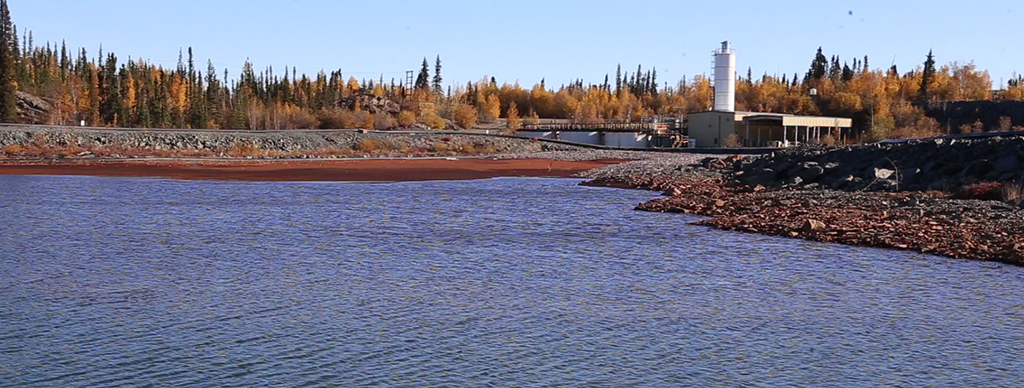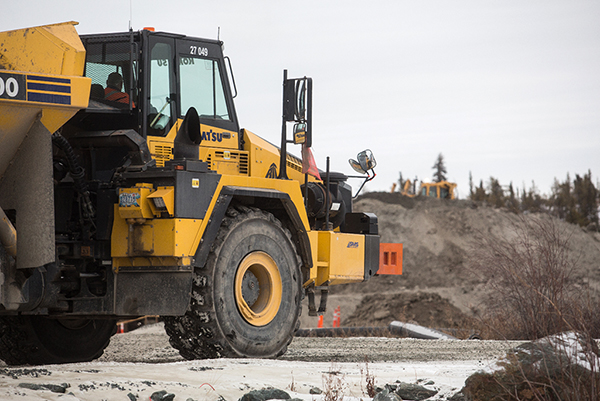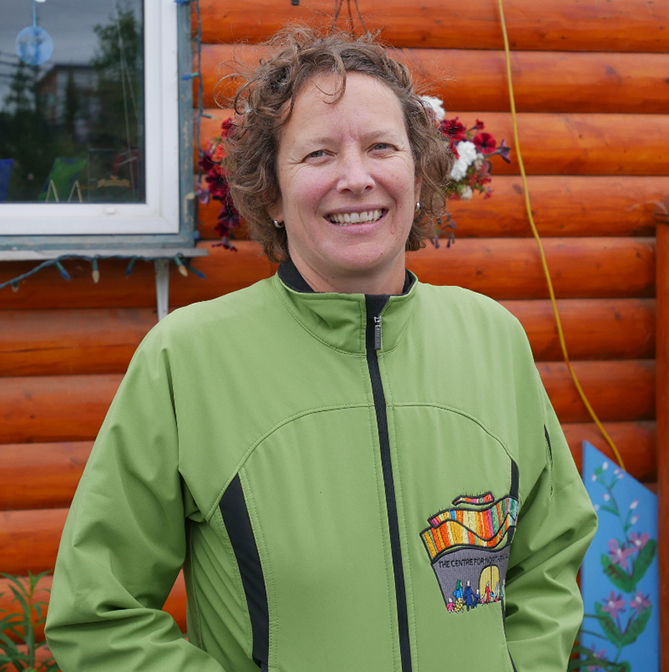Giant Mine newsletter: Summer 2020
Get the most recent updates on the Giant Mine remediation project.
On this page
Site update during the COVID-19 pandemic
The Giant Mine Remediation Project continues to maintain essential care and maintenance services which are handled mostly by local staff. Additional essential care and maintenance summer activities, such as monitoring for dust and treating water, are also underway.
In order to complete specialized work, the project needed to bring in some workers from outside the territory.
Parsons and the project brought these essential workers on board in a way that protected the workers on site and the local communities. As such, the project required these workers to follow the guidance of the Chief Public Health Officer. This included completing and submitting their self-isolation plan to the Government of the Northwest Territories for approval before entering the territory.
Any workers who were exempt from the requirements to self-isolate for 14 days upon arrival in the Northwest Territories were required to practice self-isolation and personal distancing while working at the Giant Mine Remediation Project. Strong infection control protocols such as environmental cleaning, handwashing, facial coverings, personal protective equipment and other engineering and administrative controls are in place at the site to protect workers and the community.
The project has also paused some non-essential work so that out of the territory workers limit travel into the territory. The project team will continue to work with Parsons Inc., the Chief Public Health Officer, and the Workers' Safety and Compensation Commission to determine when this work can safely resume.
Procurement update
Effluent treatment plant operations

Parsons Inc. hired a joint venture between BluMetric Environmental Inc. and Det'on Cho Management LP to operate the effluent treatment plant. The contract for this specialized service is valued at $1.6 million. As part of its successful bid, the company made Indigenous opportunities considerations commitments. This included providing 2840 training hours and committing to 35% of the labour being conducted by Indigenous staff. These commitments will help Parsons and the team deliver on some of its targets for the project's key socio-economic performance indicators. More information about the project's target developments are featured below.
Socio-economic update
The Giant Mine Remediation Project heard from community members that developing targets to measure socio-economic progress is important. Over the past year, the project's socio-economic working group, which is made up of federal, territorial, Indigenous and municipal partners, has been working to develop these targets. In 2019, the project developed and released a list of key performance indicators, which are factors the project will track to measure its progress on socio-economic goals.
With the advice from the socio-economic advisory body, made of senior-level federal, territorial, municipal and Indigenous partners, the working group has now determined some of these key performance indicators and set targets that the project aims to meet during the remediation. This will give the project team a baseline to measure progress against. The working group chose to set targets for the performance indicators over which the project has more direct influence and are focused on the types of socio-economic goals community members want to see progress on.

The targets are the following:
- employment accounted by Northern Indigenous: an initial target range of 25 to 35%
- employment accounted by Northerners: an initial target range of 55 to 70%
- employment accounted by women: an initial target range of 15 to 30%
- expenditures accounted by businesses from the North and the Northwest Territories: an initial target range of 65 to 75%
- apprenticeships: a minimum of 10 Northern and Northern Indigenous apprentices supported during the implementation phase
- scholarships: 1 scholarship per year during the implementation phase
The project team will track these targets quarterly and review them and the key performance indicators on an annual basis. This will enable the project to adjust its approach as needed over time.
More details are available on the targets and key performance indicators in the document GIANT – Evergreen – SE – Key Performance Indicators in the project's SharePoint folder.
About the socio-economic advisory body and working group
The Giant Mine Remediation Project is working to deliver socio-economic benefits to area residents as the project moves forward. The team also recognizes that it needs local partners to help achieve the most from its socio-economic plan. For that reason, in November 2018, the team formed the socio-economic advisory body. In February 2019, the team established a socio-economic working group.
Socio-economic working group
The socio-economic working group is a working-level committee that meets monthly. It is made up of representatives from multiple governments, including:
- Crown-Indigenous Relations and Northern Affairs Canada, which includes the Giant Mine Remediation Project
- the Canadian Northern Economic Development Agency
- the Government of the Northwest Territories:
- Environment and Natural Resources
- Education, Culture and Employment
- Industry, Tourism and Investment
- Public Services and Procurement Canada, which includes representatives from project management and procurement
- the Main Construction Manager, Parsons Inc.
- the City of Yellowknife
- the Yellowknives Dene First Nation
Representatives from the Giant Mine Oversight Board attend meetings of the socio-economic working group as an observer. The working group is charged with developing and rolling out the socio-economic implementation plan. It looks for opportunities to improve how members can work together to provide socio-economic benefits to the communities. The working group reports directly to, and seeks advice from, the project's management team and the socio-economic advisory body.
Socio-economic advisory body
The socio-economic advisory body is a senior executive-level committee that meets 4 times a year. It is co-chaired by:
- the Director General of Crown-Indigenous Relations and Northern Affairs Canada's Northern Contaminated Sites Branch
- the Regional Director General, Northwest Territories Region, Crown-Indigenous Relations and Northern Affairs Canada
Like the working group, it also includes members representing different governments. Alternatives North is also represented, as all parties who signed the Giant Mine Environmental Agreement. Participating parties include:
- Crown-Indigenous Relations and Northern Affairs Canada
- Northern Contaminated Sites Program, which includes the Giant Mine Remediation Project
- NWT Region executive office
- Canadian Northern Economic Development Agency
- Government of the Northwest Territories
- Environment and Natural Resources
- Industry Tourism and Investment
- Education Culture and Employment
- Public Services and Procurement Canada
- Service Canada
- City of Yellowknife
- Yellowknives Dene First Nation
- North Slave Métis Alliance
- Alternatives North
The socio-economic advisory body provides the project team with strategic advice and input on socio-economic aspects of the project. The representatives also brief their respective organizations on the project's approaches, so they can bring forward questions, concerns, and new ideas. They also help by discussing barriers to achieving the project's socio-economic goals, so the body can explore different ways to address these and help northern and Indigenous workers and businesses benefit from the Giant Mine Remediation Project as much as possible.
The project team recognizes that the coming work will help benefit the Northwest Territories' economy, and wants to ensure as many local residents and business as possible can benefit from the opportunities that arise. Working together with partners with similar socio-economic goals and mandates will help strengthen the project team's approach and help its socio-economic strategy succeed.
The project team welcomes its new engagement manager

We are happy to welcome our new engagement manager, Jessica Mace, to the project team!
Originally from Almonte, Ontario, Jessica is no stranger to the north or its contaminated sites. From 2007 to 2013, she worked in the NWT Region's Contaminants and Remediation Division, primarily on sites in the Sahtu.
Jessica holds a Master's degree in Environmental Science. She spent 7 years working in this field, across the 3 territories, at the start of her career. Her passion for working with communities began during this time, with a company called the Environmental Sciences Group. This company worked primarily on remediating sites in the Arctic. One of her favourite aspects of the job was helping train local people to do sampling and lab work so they could participate more meaningfully in these and future projects.
Ensuring area residents benefit as much as possible from projects near their communities is also what drew her to her new role with the Giant Mine Remediation Project team.
Jessica is happy to be back in the NWT and is ready to jump back into work, and play, in the north. Her husband and 3 children have returned with her, and the family is looking forward to reconnecting with old friends and to enjoying the northern outdoors and community spirit once more.
Aquatics engagement
Local people, in particular the Indigenous peoples, have a vested interest in the health of the water around Yellowknife. Members of the Indigenous communities can remember fishing and picking berries in and around Baker Creek prior to the development of the Giant Mine. The Giant Mine Remediation Project is developing work plans for Baker Creek and Yellowknife Bay. This includes developing the plans for related monitoring programs.

The project is developing an aquatic advisory committee to advise on important aspects of remediation work. The committee consists of members from the Yellowknives Dene First Nation, the North Slave Métis Alliance, and the City of Yellowknife, as well as other stakeholders and government officials. The team will hold meetings starting in the fall, and meet with the Yellowknives Dene First Nation and the North Slave Métis Alliance throughout the process. The project team will update the public at its annual public forum in spring 2021.
The project team is looking forward to understanding the point of view of the Indigenous communities and other members as it relates to the water in the area, and incorporating those items into the design plans where possible.
Moving the final health study forward
The team is getting ready to launch the final piece of the project's 3 health-related studies: the study that will measure how Giant Mine has affected the overall wellness of people who live in the Yellowknife area. It was previously referred to as a stress study, based on the wording of 1 of the measures of the Report of Environmental Assessment (PDF). However, the study team felt it was important to give the study a more meaningful name, one that better reflected its intent and resonated with members of the community. With Yellowknives Dene First Nation partners, the study team has named it Hoèła Weteèts'eèdeè: Overcoming Hardships from Giant Mine. The study itself is a collaborative research partnership between Wilfrid Laurier University and the Yellowknives Dene First Nation. Dr. Ketan Shankardass, the principal investigator, and his team are in the process of finalizing the study's design.
The study recently hired Laura Busch as Project Coordinator. Laura is located in Yellowknife and will work with Dr. Shankardass' research team.
You can expect to hear more from the project team about Hoèła Weteèts'eèdeè in the coming months.
Related links
For more information about the other 2 health-related studies, visit: